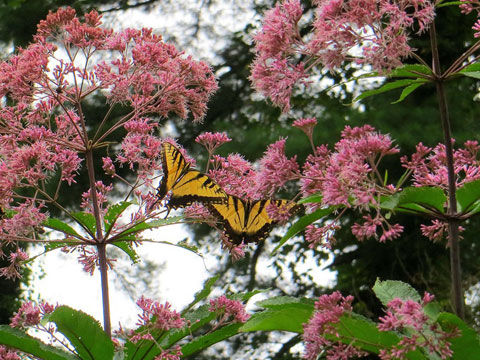GARDEN CENTER • GIFT SHOP • LANDSCAPE DESIGN • FIREWOOD
3460 Dundee Road
Northbrook, Illinois 60062
T. (847) 272-1209
F. (847) 272-1417
reds@redsgardencenter.com
Perennials
Perennials are plants that live year after year. Most garden flowers are perennials. This means the tops of the plants – the leaves,
stems, and flowers – die back to the ground each fall with the first frost or freeze. The roots persist through the winter and every spring, new
plant tops arise.
It is best to select plants with a purpose in mind, such as edging plants, accents for evergreens, masses of color, rock garden specimens, etc. With
specific purposes in mind, you can choose perennials by considering their characteristics and deciding which plants best meet your requirements.
With careful planning, a perennial flowerbed will change colors, as one type of plant finishes and another variety begins to bloom. By combining
perennials with annuals, a continuous colorful show can be provided in your garden.
The University of Illinois Extension has created a Web site
titled "Gardening with Perennials"
that includes a comprehensive directory of perennials and guides for specific uses and planting locations. But the best way to make wise
choices is to check with the garden professionals at Reds. We'll help you select the best perennials for your purpose and design,
resulting in a garden that is both aesthetic and functional.

Joe Pye Weed
Plant List
Our Plant List includes the names of perennials we commonly carry. While these plants will all be available at some point, we cannot guarantee that they will be in stock on any given day. So if you're looking for something specific, please call ahead or email us for current availability. We're here to help!
Achillea – Yarrow
Agastache – Hyssop
Alcea – Hollyhock
Alchemilla – Lady's Mantle
Allium – Ornamental Onion
Amsonia – Blue Star
Anemone – Anemone
Aquilegia – Columbine
Arisaema – Wormwood
Aruncus – Goats Beard
Asclepias – Butterfly Weed
Asparagus – Asparagus
Aster – Aster
Astilbe – Astilbe
Baptisia – Blue Wild Indigo
Bergenia – Pig Squeak
Brunnera – Siberian Bugloss
Campanula – Bellflower
Centaurea – Bachelor Button
Chelone – Turtlehead
Cimicifuga – Bugbane/Snakeroot
Clematis – Clematis
Convallaria – Lily of the Valley
Coreopsis – Tickseed
Delosperma – Ice Plant
Delphinium – Larkspur
Dianthus – Carnation
Dicentra – Bleeding Heart
Digitalis – Foxglove
Echinacea – Coneflower
Echinops – Globe Thistle
Echium – Bitterroot
Epimedium – Barren Wort
Eryngium – Sea Holly
Eupatorium – Pye Weed
Euphorbia – Cushion Spurge
Fallopia – Fleece Flower
Fern – Fern
Gaillardia – Blanketflower
Galium – Sweet Woodruff
Gaura – Gaura
Geranium – Cranesbill
Helenium – Sneezeweed
Heliopsis – Sunflower
Helleborus – Lenten Rose
Hemerocallis – Daylily
Heuchera – Coral Bells
Heucherella – Foamy Bells
Hibiscus – Mallow
Hosta – Hosta
Houttuynnia – Houttuynnia
Iberis – Candytuft
Iris – Iris
Itoh – Hybrid Tree Peony
Lamium – Dead Nettle
Lavendula – Lavender
Leucanthemum – Shasta Daisy
Liatris – Blazing Star
Ligularia – Leopard Plant
Lilium – Asiatic Lily
Liriope – Lilyturf
Lobelia – Cardinal Flower
Lupinus – Lupine
Lysmachia – Loosestrife
Malva – Rose Mallow
Mertensis – Virginia Bluebells
Monarda – Bee Balm
Myosotis – Forget-Me-Nots
Nepeta – Catmint
Oenothera – Sundrops
Paeonia – Peony
Papaver – Poppy
Penstemon – Beardtongue
Perovskia – Russian Sage
Persicaria – Snakeweed, Fleece Flower
Phlox – Phlox
Physotegia – Obedient Plant
Platycodon – Balloonflower
Polemonium – Jacob's Ladder
Polygonatum – Solomons Seal
Pulmonaria – Lungwort
Ratibida – Mexican Hat Plant
Rudbeckia – Blackeye Susan
Salvia – Meadow Sage
Scabiosa – Pin Cushion
Sedum – Sedum
Sempervivum – Hens and Chicks
Sisyrinchium – Blue Eye Grass
Solidago – Goldenrod
Stachys – Lambs Ear
Thymus – Thyme
Tiarella – Foam Flower
Tradescantia – Spiderwort
Veronica – Speedwell
Viola
Links to individuals or instututions does not constitute an endorsement of any information, product, or service you may receive from such sources.
